HRMT20024 - Performance Management: Trends and Research Analysis
VerifiedAdded on 2023/06/07
|5
|999
|209
Presentation
AI Summary
This document presents a student's analysis of performance management based on two research articles. The first article examines performance appraisal during economic crises, highlighting the gap between explicit and implicit expectations and the challenges of cultural differences. It suggests a more formal appraisal process that considers contextual and cultural factors. The second article explores the relationship between rewards and employee creativity, finding that intrinsic motivation linked to intrinsic tasks yields the best results, while extrinsic rewards are contingent on personal and contextual factors. The analysis provides insights into improving performance management systems by addressing cultural nuances and aligning rewards with employee motivation. Desklib offers a platform for students to access similar solved assignments and past papers.
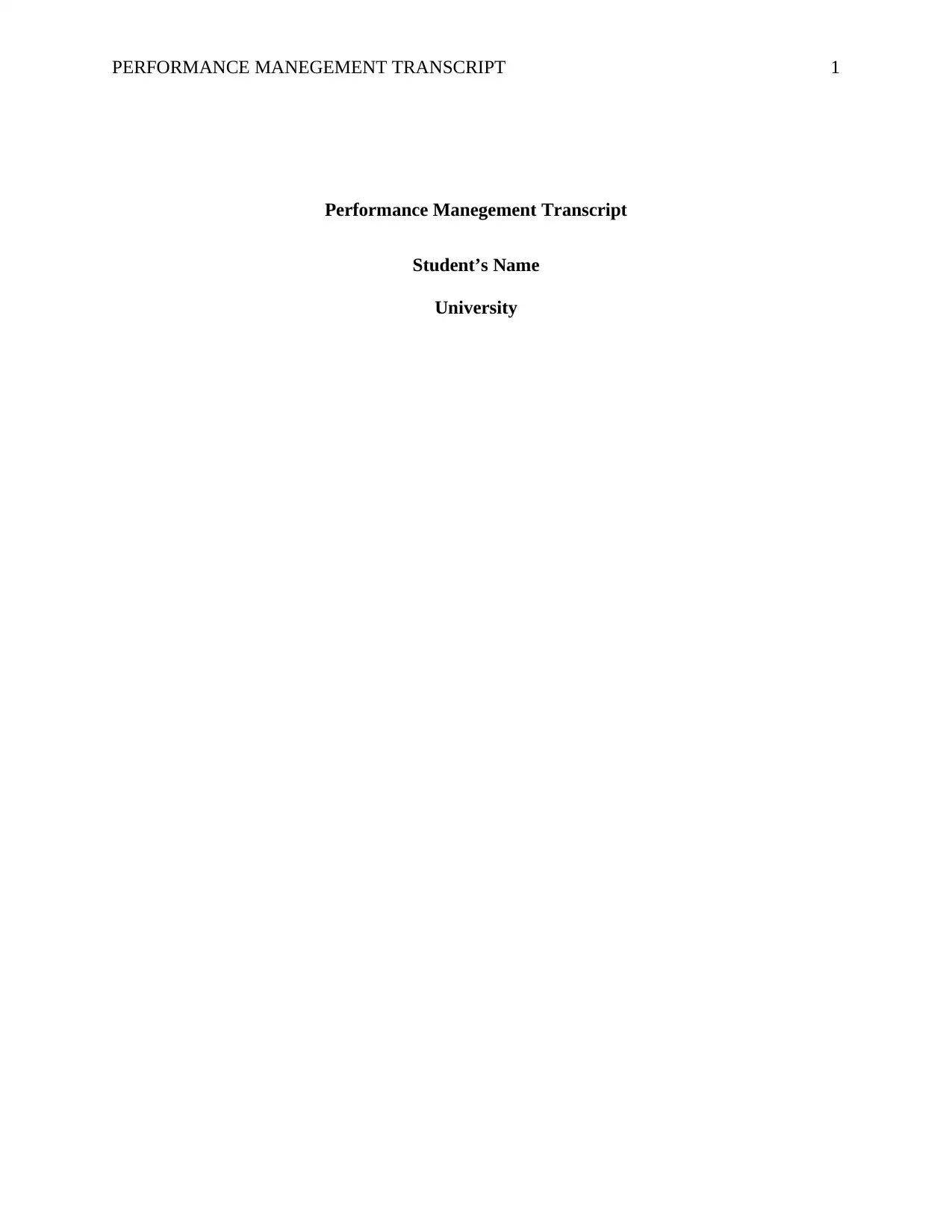
PERFORMANCE MANEGEMENT TRANSCRIPT 1
Performance Manegement Transcript
Student’s Name
University
Performance Manegement Transcript
Student’s Name
University
Paraphrase This Document
Need a fresh take? Get an instant paraphrase of this document with our AI Paraphraser
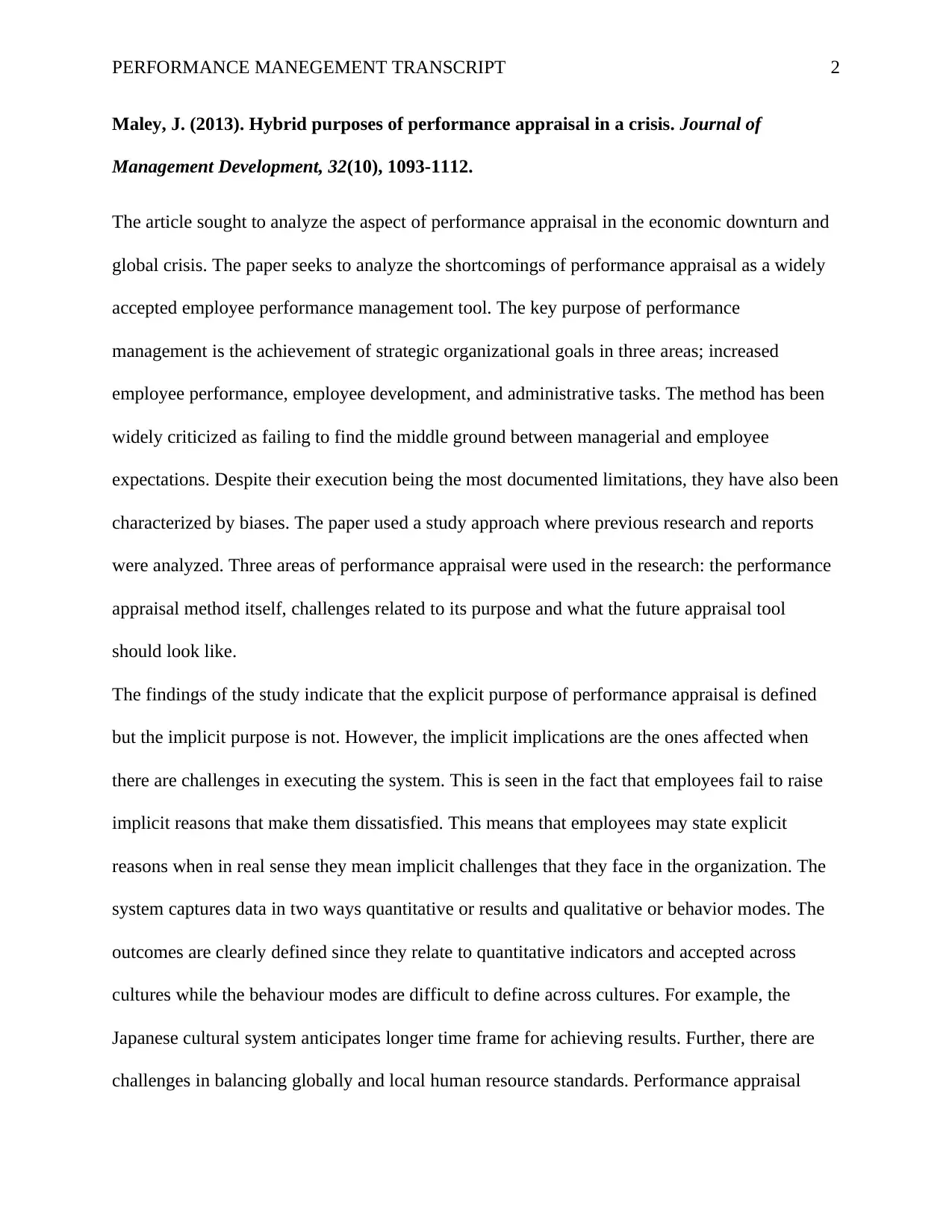
PERFORMANCE MANEGEMENT TRANSCRIPT 2
Maley, J. (2013). Hybrid purposes of performance appraisal in a crisis. Journal of
Management Development, 32(10), 1093-1112.
The article sought to analyze the aspect of performance appraisal in the economic downturn and
global crisis. The paper seeks to analyze the shortcomings of performance appraisal as a widely
accepted employee performance management tool. The key purpose of performance
management is the achievement of strategic organizational goals in three areas; increased
employee performance, employee development, and administrative tasks. The method has been
widely criticized as failing to find the middle ground between managerial and employee
expectations. Despite their execution being the most documented limitations, they have also been
characterized by biases. The paper used a study approach where previous research and reports
were analyzed. Three areas of performance appraisal were used in the research: the performance
appraisal method itself, challenges related to its purpose and what the future appraisal tool
should look like.
The findings of the study indicate that the explicit purpose of performance appraisal is defined
but the implicit purpose is not. However, the implicit implications are the ones affected when
there are challenges in executing the system. This is seen in the fact that employees fail to raise
implicit reasons that make them dissatisfied. This means that employees may state explicit
reasons when in real sense they mean implicit challenges that they face in the organization. The
system captures data in two ways quantitative or results and qualitative or behavior modes. The
outcomes are clearly defined since they relate to quantitative indicators and accepted across
cultures while the behaviour modes are difficult to define across cultures. For example, the
Japanese cultural system anticipates longer time frame for achieving results. Further, there are
challenges in balancing globally and local human resource standards. Performance appraisal
Maley, J. (2013). Hybrid purposes of performance appraisal in a crisis. Journal of
Management Development, 32(10), 1093-1112.
The article sought to analyze the aspect of performance appraisal in the economic downturn and
global crisis. The paper seeks to analyze the shortcomings of performance appraisal as a widely
accepted employee performance management tool. The key purpose of performance
management is the achievement of strategic organizational goals in three areas; increased
employee performance, employee development, and administrative tasks. The method has been
widely criticized as failing to find the middle ground between managerial and employee
expectations. Despite their execution being the most documented limitations, they have also been
characterized by biases. The paper used a study approach where previous research and reports
were analyzed. Three areas of performance appraisal were used in the research: the performance
appraisal method itself, challenges related to its purpose and what the future appraisal tool
should look like.
The findings of the study indicate that the explicit purpose of performance appraisal is defined
but the implicit purpose is not. However, the implicit implications are the ones affected when
there are challenges in executing the system. This is seen in the fact that employees fail to raise
implicit reasons that make them dissatisfied. This means that employees may state explicit
reasons when in real sense they mean implicit challenges that they face in the organization. The
system captures data in two ways quantitative or results and qualitative or behavior modes. The
outcomes are clearly defined since they relate to quantitative indicators and accepted across
cultures while the behaviour modes are difficult to define across cultures. For example, the
Japanese cultural system anticipates longer time frame for achieving results. Further, there are
challenges in balancing globally and local human resource standards. Performance appraisal
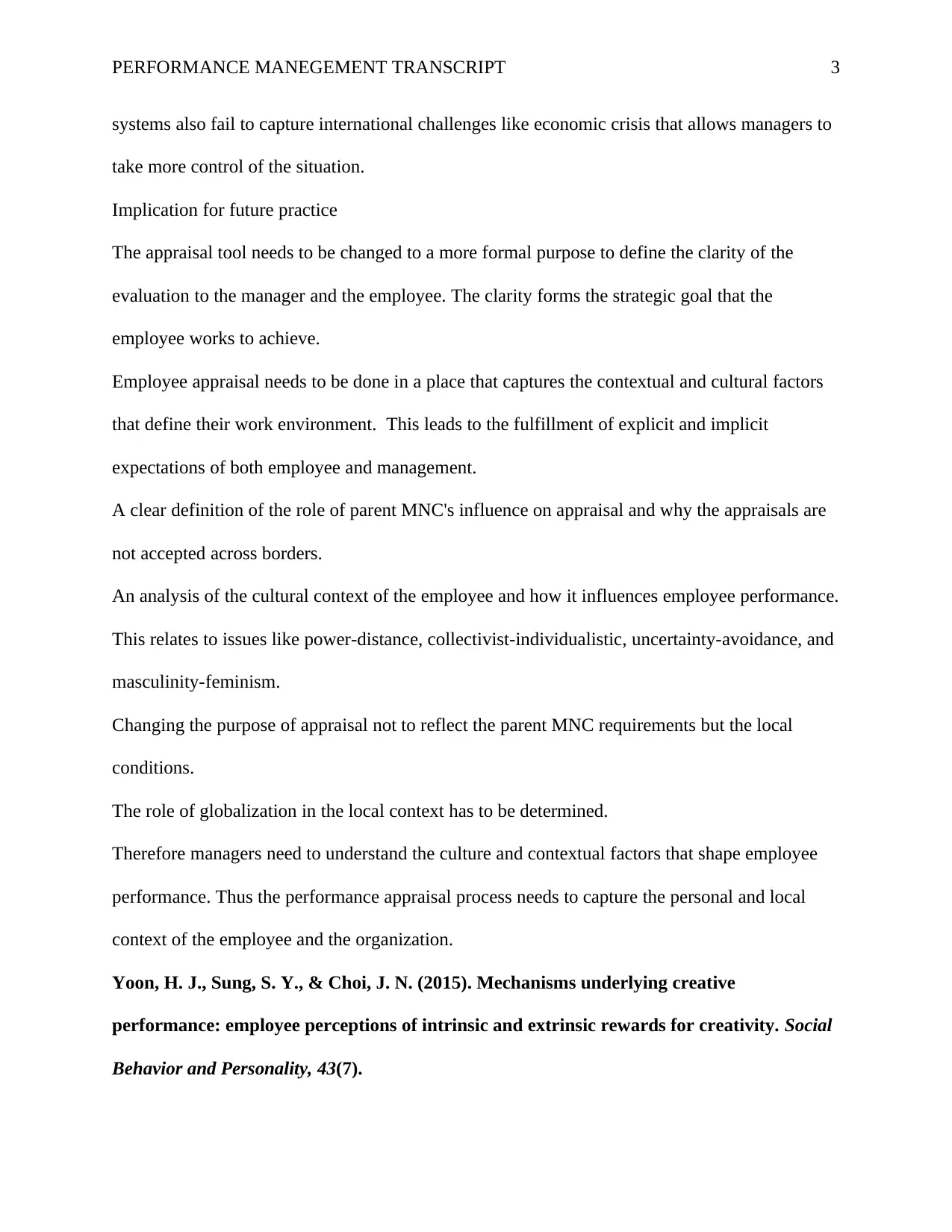
PERFORMANCE MANEGEMENT TRANSCRIPT 3
systems also fail to capture international challenges like economic crisis that allows managers to
take more control of the situation.
Implication for future practice
The appraisal tool needs to be changed to a more formal purpose to define the clarity of the
evaluation to the manager and the employee. The clarity forms the strategic goal that the
employee works to achieve.
Employee appraisal needs to be done in a place that captures the contextual and cultural factors
that define their work environment. This leads to the fulfillment of explicit and implicit
expectations of both employee and management.
A clear definition of the role of parent MNC's influence on appraisal and why the appraisals are
not accepted across borders.
An analysis of the cultural context of the employee and how it influences employee performance.
This relates to issues like power-distance, collectivist-individualistic, uncertainty-avoidance, and
masculinity-feminism.
Changing the purpose of appraisal not to reflect the parent MNC requirements but the local
conditions.
The role of globalization in the local context has to be determined.
Therefore managers need to understand the culture and contextual factors that shape employee
performance. Thus the performance appraisal process needs to capture the personal and local
context of the employee and the organization.
Yoon, H. J., Sung, S. Y., & Choi, J. N. (2015). Mechanisms underlying creative
performance: employee perceptions of intrinsic and extrinsic rewards for creativity. Social
Behavior and Personality, 43(7).
systems also fail to capture international challenges like economic crisis that allows managers to
take more control of the situation.
Implication for future practice
The appraisal tool needs to be changed to a more formal purpose to define the clarity of the
evaluation to the manager and the employee. The clarity forms the strategic goal that the
employee works to achieve.
Employee appraisal needs to be done in a place that captures the contextual and cultural factors
that define their work environment. This leads to the fulfillment of explicit and implicit
expectations of both employee and management.
A clear definition of the role of parent MNC's influence on appraisal and why the appraisals are
not accepted across borders.
An analysis of the cultural context of the employee and how it influences employee performance.
This relates to issues like power-distance, collectivist-individualistic, uncertainty-avoidance, and
masculinity-feminism.
Changing the purpose of appraisal not to reflect the parent MNC requirements but the local
conditions.
The role of globalization in the local context has to be determined.
Therefore managers need to understand the culture and contextual factors that shape employee
performance. Thus the performance appraisal process needs to capture the personal and local
context of the employee and the organization.
Yoon, H. J., Sung, S. Y., & Choi, J. N. (2015). Mechanisms underlying creative
performance: employee perceptions of intrinsic and extrinsic rewards for creativity. Social
Behavior and Personality, 43(7).
⊘ This is a preview!⊘
Do you want full access?
Subscribe today to unlock all pages.

Trusted by 1+ million students worldwide
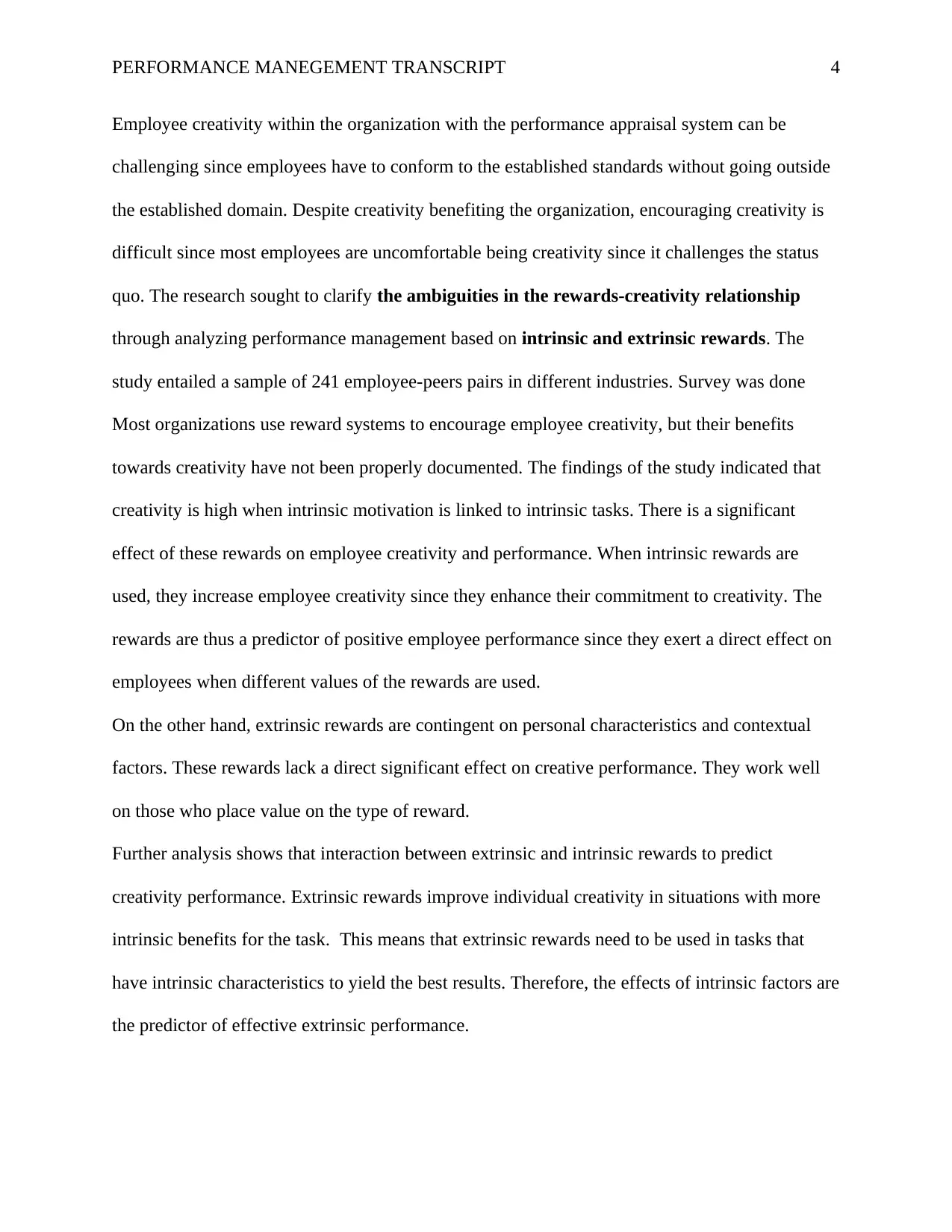
PERFORMANCE MANEGEMENT TRANSCRIPT 4
Employee creativity within the organization with the performance appraisal system can be
challenging since employees have to conform to the established standards without going outside
the established domain. Despite creativity benefiting the organization, encouraging creativity is
difficult since most employees are uncomfortable being creativity since it challenges the status
quo. The research sought to clarify the ambiguities in the rewards-creativity relationship
through analyzing performance management based on intrinsic and extrinsic rewards. The
study entailed a sample of 241 employee-peers pairs in different industries. Survey was done
Most organizations use reward systems to encourage employee creativity, but their benefits
towards creativity have not been properly documented. The findings of the study indicated that
creativity is high when intrinsic motivation is linked to intrinsic tasks. There is a significant
effect of these rewards on employee creativity and performance. When intrinsic rewards are
used, they increase employee creativity since they enhance their commitment to creativity. The
rewards are thus a predictor of positive employee performance since they exert a direct effect on
employees when different values of the rewards are used.
On the other hand, extrinsic rewards are contingent on personal characteristics and contextual
factors. These rewards lack a direct significant effect on creative performance. They work well
on those who place value on the type of reward.
Further analysis shows that interaction between extrinsic and intrinsic rewards to predict
creativity performance. Extrinsic rewards improve individual creativity in situations with more
intrinsic benefits for the task. This means that extrinsic rewards need to be used in tasks that
have intrinsic characteristics to yield the best results. Therefore, the effects of intrinsic factors are
the predictor of effective extrinsic performance.
Employee creativity within the organization with the performance appraisal system can be
challenging since employees have to conform to the established standards without going outside
the established domain. Despite creativity benefiting the organization, encouraging creativity is
difficult since most employees are uncomfortable being creativity since it challenges the status
quo. The research sought to clarify the ambiguities in the rewards-creativity relationship
through analyzing performance management based on intrinsic and extrinsic rewards. The
study entailed a sample of 241 employee-peers pairs in different industries. Survey was done
Most organizations use reward systems to encourage employee creativity, but their benefits
towards creativity have not been properly documented. The findings of the study indicated that
creativity is high when intrinsic motivation is linked to intrinsic tasks. There is a significant
effect of these rewards on employee creativity and performance. When intrinsic rewards are
used, they increase employee creativity since they enhance their commitment to creativity. The
rewards are thus a predictor of positive employee performance since they exert a direct effect on
employees when different values of the rewards are used.
On the other hand, extrinsic rewards are contingent on personal characteristics and contextual
factors. These rewards lack a direct significant effect on creative performance. They work well
on those who place value on the type of reward.
Further analysis shows that interaction between extrinsic and intrinsic rewards to predict
creativity performance. Extrinsic rewards improve individual creativity in situations with more
intrinsic benefits for the task. This means that extrinsic rewards need to be used in tasks that
have intrinsic characteristics to yield the best results. Therefore, the effects of intrinsic factors are
the predictor of effective extrinsic performance.
Paraphrase This Document
Need a fresh take? Get an instant paraphrase of this document with our AI Paraphraser
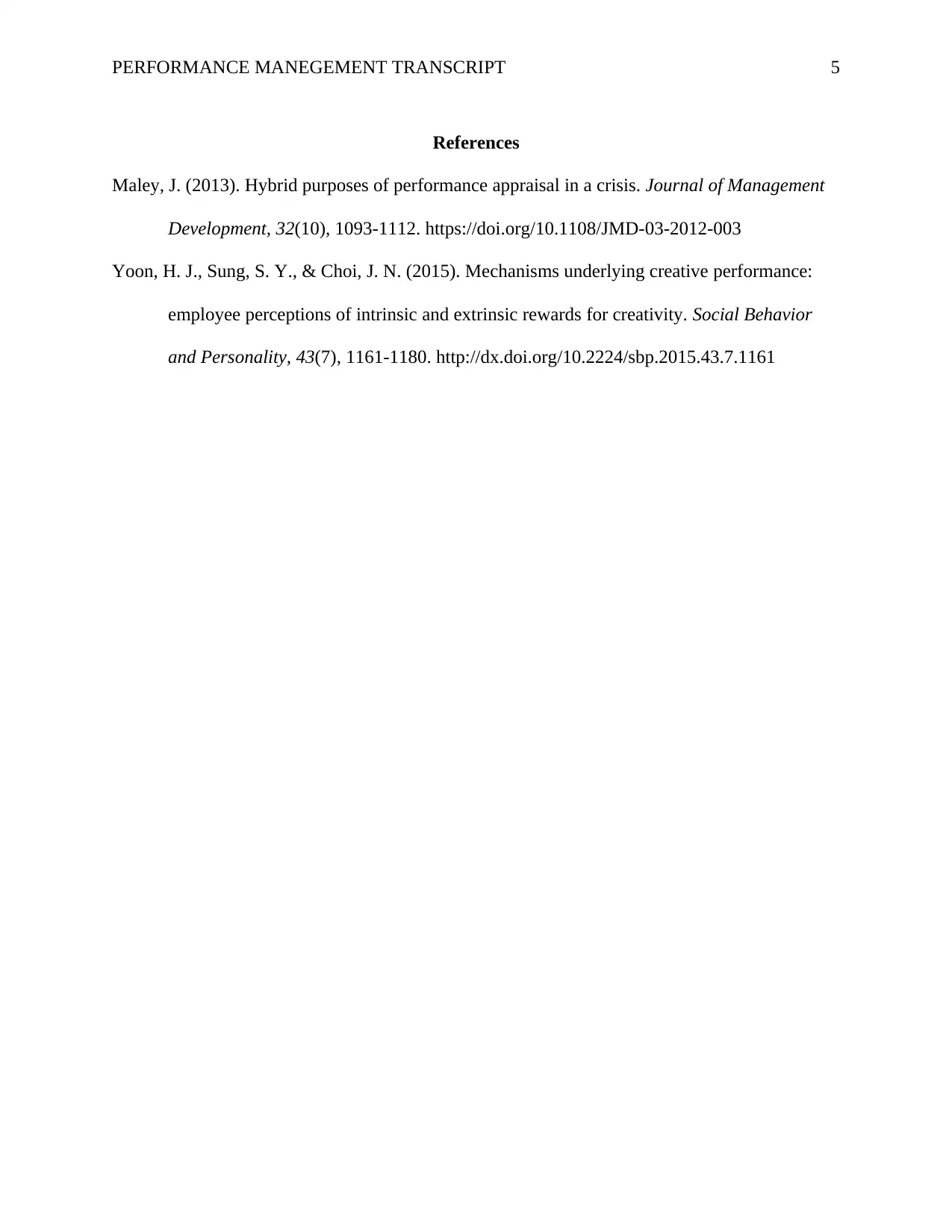
PERFORMANCE MANEGEMENT TRANSCRIPT 5
References
Maley, J. (2013). Hybrid purposes of performance appraisal in a crisis. Journal of Management
Development, 32(10), 1093-1112. https://doi.org/10.1108/JMD-03-2012-003
Yoon, H. J., Sung, S. Y., & Choi, J. N. (2015). Mechanisms underlying creative performance:
employee perceptions of intrinsic and extrinsic rewards for creativity. Social Behavior
and Personality, 43(7), 1161-1180. http://dx.doi.org/10.2224/sbp.2015.43.7.1161
References
Maley, J. (2013). Hybrid purposes of performance appraisal in a crisis. Journal of Management
Development, 32(10), 1093-1112. https://doi.org/10.1108/JMD-03-2012-003
Yoon, H. J., Sung, S. Y., & Choi, J. N. (2015). Mechanisms underlying creative performance:
employee perceptions of intrinsic and extrinsic rewards for creativity. Social Behavior
and Personality, 43(7), 1161-1180. http://dx.doi.org/10.2224/sbp.2015.43.7.1161
1 out of 5
Your All-in-One AI-Powered Toolkit for Academic Success.
+13062052269
info@desklib.com
Available 24*7 on WhatsApp / Email
![[object Object]](/_next/static/media/star-bottom.7253800d.svg)
Unlock your academic potential
Copyright © 2020–2025 A2Z Services. All Rights Reserved. Developed and managed by ZUCOL.
